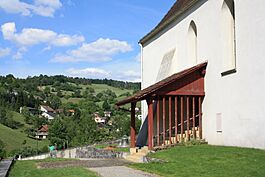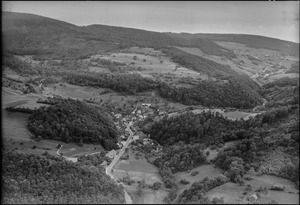Densbüren facts for kids
Quick facts for kids
Densbüren
|
||
|---|---|---|
 |
||
|
||
| Country | Switzerland | |
| Canton | Aargau | |
| District | Aarau | |
| Area | ||
| • Total | 12.52 km2 (4.83 sq mi) | |
| Elevation | 481 m (1,578 ft) | |
| Population
(Dec 2020 )
|
||
| • Total | 728 | |
| • Density | 58.15/km2 (150.60/sq mi) | |
| Postal code |
5026
|
|
| Localities | Densbüren, Asp | |
| Surrounded by | Herznach, Küttigen, Oberhof, Thalheim, Wölflinswil, Zeihen | |
Densbüren is a small town, also called a municipality, located in the Aarau District within the Aargau region of Switzerland. It's a lovely place in a beautiful country!
Contents
A Glimpse into Densbüren's Past
Densbüren has a long history. It was first written about in the 1300s. Back then, people called it Tensbuirron. Later, in 1426, its name was recorded as Teinspuiren.
Where is Densbüren Located?
Densbüren is in the Aarau District. It sits on the northern side of the Staffelegg Pass. This pass is a very important route over the Jura Mountains.
The municipality includes the main village of Densbüren. It also has smaller areas called hamlets, like Asp.
How Big is Densbüren?
As of 2006, Densbüren covers an area of about 12.6 square kilometers (4.9 square miles). A large part of this land, about 55.7%, is covered by forests. This means there are lots of trees!
About 39.2% of the land is used for farming. This includes fields and pastures. A smaller part, 4.8%, has buildings and roads. The rest is made up of rivers or lakes.
What Does Densbüren's Coat of Arms Look Like?
The official symbol of Densbüren is its coat of arms. It features a green pine tree. This tree stands on green hills. All of this is set against a silver background with a red border.
Who Lives in Densbüren?
Densbüren has a population of about 700 people. As of 2008, a small part of the population, about 7.7%, were people from other countries. Over the last 10 years, the number of people living here has slightly decreased.
What Languages Do People Speak?
Most people in Densbüren speak German. In fact, about 98.2% of the population speaks German. The next most common language is Albanian, followed by Serbo-Croatian.
How Old Are the People in Densbüren?
In 2008, the age groups in Densbüren were:
- Children aged 0-9 years: 7.8%
- Young people aged 10-19 years: 15.4%
- Adults aged 20-29 years: 11.6%
- Adults aged 30-39 years: 11.0%
- Adults aged 40-49 years: 17.6%
- Adults aged 50-59 years: 15.0%
- Adults aged 60-69 years: 10.3%
- Seniors aged 70-79 years: 7.1%
- Seniors aged 80-89 years: 3.6%
- Seniors aged 90+ years: 0.4%
How Many Homes Are There?
In 2000, there were 25 homes with 1 or 2 people living in them. There were 98 homes with 3 or 4 people. Also, 135 homes had 5 or more people. On average, each home had about 2.62 people.
In 2008, about half of all homes were single-family houses. There were 151 single-family homes out of 303 total homes and apartments.
Education in Densbüren
Many adults in Densbüren have completed higher education. About 77.1% of people aged 25-64 have finished either advanced high school or university. In the 2008/2009 school year, 44 students attended primary school in the municipality.
Historical Population Growth
The population of Densbüren has changed over the years:
| Year | Population |
|---|---|
| 1764 | 469 |
| 1798 | 666 |
| 1850 | 1167 |
| 1900 | 934 |
| 1950 | 772 |
| 1980 | 596 |
| 2000 | 720 |
Important Historical Sites
Densbüren is home to a special historical place. The old Urgiz Castle is a ruined castle. It is recognized as a very important national heritage site in Switzerland.
Jobs and Economy in Densbüren
In 2007, the unemployment rate in Densbüren was very low, at 1.42%. This means most people who wanted to work had jobs.
What Kinds of Jobs Are There?
As of 2005, many people worked in different areas:
- Farming: 81 people worked in farming, like growing crops or raising animals. There were 28 businesses in this area.
- Industry: 98 people worked in factories or making things. There were 10 businesses in this area.
- Services: 88 people worked in jobs like shops, schools, or healthcare. There were 20 businesses in this area.
Commuting for Work
In 2000, 361 people who lived in Densbüren had jobs. Most of them, about 70.6%, traveled outside Densbüren for work. However, 100 people came into Densbüren to work. Overall, there were 206 jobs available in the municipality.
Religious Beliefs
According to the 2000 census, most people in Densbüren belong to the Swiss Reformed Church, about 73.4%. Another 15.7% of the population are Roman Catholic.
See also
 In Spanish: Densbüren para niños
In Spanish: Densbüren para niños





